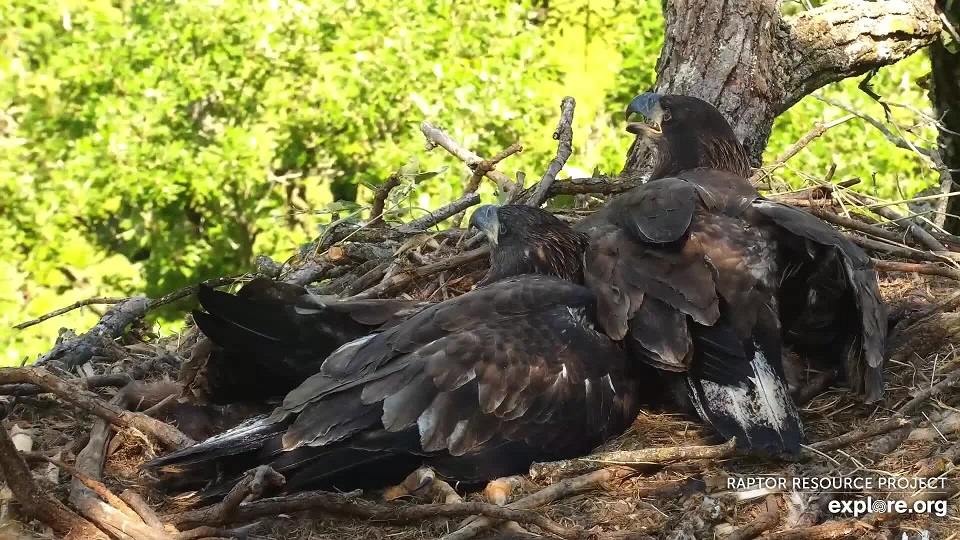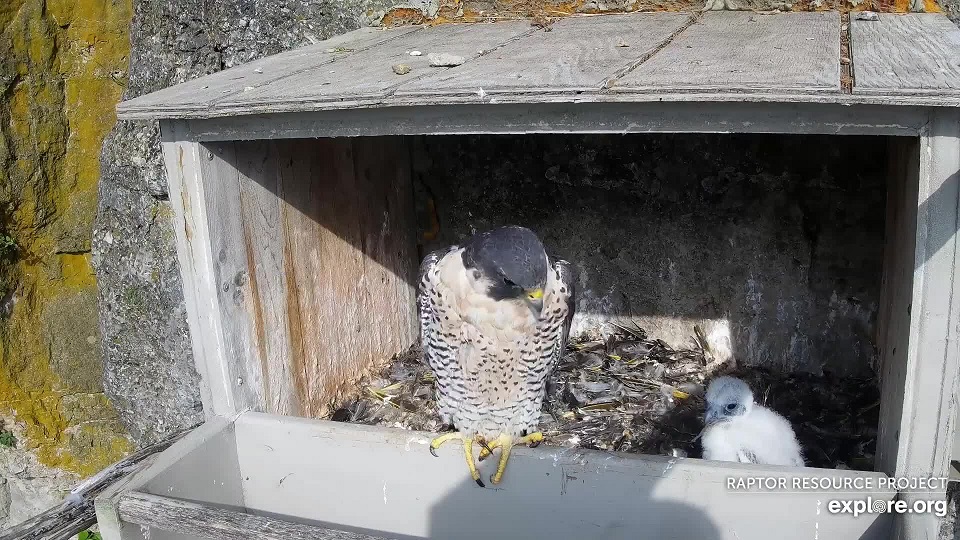We have your NestFlix! At Decorah North, DN13 and DN14 do the Eagle Stomp, continue their flight lessons, and play in the stream. At GSB, nestling falcon Chance sports a cropzilla (Zooey has clearly learned the ins and outs of feeding!) and works on her adult vocalizations as she keks at and tracks something we can’t see.
We apologize for the May/June hiatus, although we have some wonderful news! We have banded 79 falcons so far: our best and busiest field season to date. We’ll be talking about that more in the weeks to come. Thanks so much for watching and learning with us!
Decorah North Eagles

June 22, 2021: DN13 and DN14 relax in the North Nest hammock
June 22, 2021: Flying practice, antics on the ground – https://youtu.be/yUnJ2cWmFQc. It’s outdoors school! DN13 and DN14 have graduated to eagle college with full fledging honors! I enjoyed the busy airstrip at the beginning of the video and was fascinated by their pouncing behavior throughout. We know that young peregrine and kestrel falcons often hunt dragonflies and other insects before moving on to larger prey. It looks like the same thing might be happening here.
June 22, 2021: Love to see an eagle walk and run! https://youtu.be/SIdCDDcFWcQ. Watch the whole video or start at 2:07 to see the dinosaur stomp! We’ve had a couple of questions about the amount of time that DN13 and DN14 are spending on the ground. Why are they doing that? I suspect it’s because they can! The two are gaining their wings in a very remote area, with little human disturbance in the way of cars or people. This gives them a great chance to practice important skills like lift-offs, landings, pouncing, and rudimentary hunting. I hope you enjoy the Eagle Trot as much as we did!
Why do eagles look so funny when they walk? Most land animals, including us, move forwards by swinging their legs back and forth from their hips (hip-driven locomotion). However, birds keep their hips extremely bent, which points their thighs forward, and move around mostly by swinging their lower legs from the knee (knee-driven locomotion). Think of the two-legged human body. Our head is in line with our feet and our weight is balanced over our hips. But birds carry most of their weight forward of their hips, which means that their legs need to point significantly forward to balance their weight. Swinging their knees keeps their weight balanced over their legs and gives them their distinctive dinosaur walk.
June 20, 2021: DN14 close-up in the rain – https://youtu.be/XDx7jb5M1-k. DN13 and DN14 have been exploring their world, but they still return to the North nest. This is a beautiful portrait of DN14, including wonderful looks at her lovely tailfeathers, wet and shiny with rain.
June 20, 2021: DN13 plays in the stream, hiding behind the leaves – https://youtu.be/ZJ9A0UBacvY. Splish-splash, it’s an eagle bath! Bathing helps keep eagle feathers in tip-top shape by removing dirt, dust, and parasites. It also feels good in hot weather!
Great Spirit Bluff Falcons

June 23: Zooey and Chance
June 22, 2021: Chance tracking and kekking – https://youtu.be/VrdbGBc7Jas. Look at that swollen little crop! Nestling falcon Chance tracks something outside the nest box and keks in response.
We believe that Chance is 20 days old as of this video (hatching order was a little uncertain given egg timing this year). Her pinfeathers are emerging nicely and she appears to be putting on weight very rapidly. We found no ectoparasites or excrements when we banded her on Saturday, June 19, which means our treatment worked. She should be in the nest box for about another 20 days before she fledges! While nothing is certain, Zooey’s fierce defense of her nest box should give any potential flying predators second thought. She certainly got up close and personal with John!
Peregrine falcons kek or kak, chup, and wail. Their vocalizations sound like this:
- Peregrine falcons kek in alarm and in conjunction with nest defense. This call tells enemies that they need to leave now or face the consequences.
- Peregrine falcons wail to complain and call attention. They might want to copulate, eat, exchange incubation duties, are generally annoyed, or see something they don’t like off in the distance. I think of it as the ‘Get your tailfeathers over here!’ call when it occurs between mated pairs.
- Peregrine falcons usually make chups or e-chups to other peregrines in a friendly and/or encouraging context. Mates make them to mates, courting falcons make them to one another, and parents make them to young as they hatch and during feeding. However, peregrine falcons will also sometimes chup at other peregrine intruders and we’ve heard chupping when we came to band at sites that turned out to have failed.
Odds and Ends
I prefer happy and interesting news, but I think this is something people should be aware of: https://www.nbcnews.com/news/us-news/scientists-don-t-know-why-hundreds-birds-are-getting-sick-n1271936. We haven’t seen any signs of this in any of the birds we watch, and we’ve banded a record number of falcons this year. But if you are finding an unusual number of dead birds in your yard or neighborhood, contact your state’s DNR/Wildlife Division. You can get contact information by going to their website.
 The Raptor Resource Project
The Raptor Resource Project The Raptor Resource Project
The Raptor Resource Project